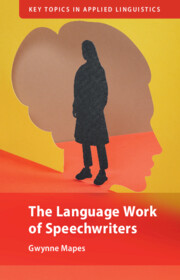Refine search
Actions for selected content:
3 results

The Language Work of Speechwriters
-
- Published online:
- 31 October 2025
- Print publication:
- 14 August 2025
1 - Introduction
-
- Book:
- The Language Work of Speechwriters
- Published online:
- 31 October 2025
- Print publication:
- 14 August 2025, pp 1-35
-
- Chapter
- Export citation
2 - Designing Words
- from I - Mapping the Profession: The Language Work of UX Writers
-
- Book:
- The Cultural Politics of Digital User Experience Writing
- Published online:
- 24 July 2025
- Print publication:
- 07 August 2025, pp 29-54
-
- Chapter
- Export citation
